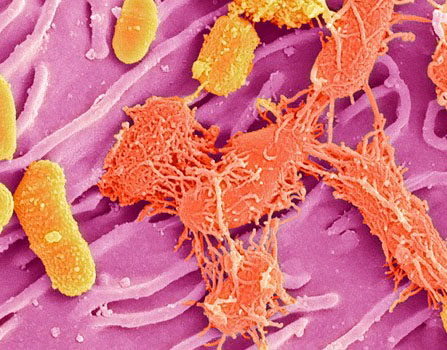A New Understanding of What’s Living on Your Skin
Five Questions with Dr. Heidi Kong and Dr. Julia Segre

IRP research is shedding light on the differences between the microorganisms that live on the skin of healthy people and patients with skin diseases.
When people think of skin health, they often think of protecting it from harmful UV rays or finding ways to avoid the fine lines and wrinkles that often come with aging and sun exposure. However, there are many factors and illnesses that impact skin health, including eczema, a chronic condition that affects tens of millions of Americans and causes the skin to become red and so itchy that it can interfere with patients’ sleep.
To combat such conditions, IRP researchers have spent decades investigating what causes them in humans through techniques such as immunology, genetics, molecular biology, and structural biology. In a 2014 study of healthy volunteers, IRP investigators Julia Segre, Ph.D., and Heidi Kong, M.D., M.H.Sc., used the latest genomic techniques to investigate the collection of microorganisms living on healthy human skin, known as the skin microbiome, in an attempt to understand how this collection of bacteria, fungi, and viruses may contribute to skin health. From their interdisciplinary research, the team was able to show that the array of microbes living on human skin is extremely diverse, varying greatly from individual to individual and between different areas of the body. This research opened doors for additional studies exploring how changes in the skin microbiome contribute to both common and rare skin diseases.
In recognition of National Healthy Skin Month in November, I spoke with Dr. Kong and Dr. Segre to discuss their research on the skin microbiome, how their work has evolved since their original studies, and what future directions they are pursuing.
What prompted you to conduct this study together?
Dr. Segre: “In 2007, two dermatology colleagues, Dr. Mark Udey and Dr. Maria Turner, introduced me to Heidi. At the time, Heidi was a clinical researcher with training in dermatology and patient-oriented research, and I was a basic scientist with experience in genomics and skin research. It was through this introduction that we found we were both interested in understanding the role that the microbiome’s collection of bacteria, fungi, and viruses had on skin diseases and overall skin health.
“Through our complementary skills and overlapping scientific interests, we decided to initiate an interdisciplinary project to understand the human skin microbiota associated with common and rare skin disorders. We used genomic techniques and clinical research to further the understanding of the microbial landscape as it relates to skin in healthy individuals, as well as in patients with eczema.”
What was the most challenging aspect of this study?

Dr. Julie Segre
Dr. Segre: “There was a large number of obstacles that we needed to overcome in order to build a collaborative study. We collected samples from our first five volunteers as a pilot study under the dermatology clinical protocol, but after that we needed to write our own protocol to move forward with our study. Although this was a time-consuming step, it ultimately allowed us to recruit 300 subjects over the past ten years.
“In addition, we needed to cross-train clinical and laboratory staff to successfully build a team of researchers from different backgrounds.”
Dr. Kong: “This type of highly translational research requires Julie and me to have a broad understanding of several different scientific areas. In order to enable our integrated teams to function effectively, we both need to be able to understand the various aspects of this multidisciplinary research. We have spent a lot of time thinking through how to best ensure that our teams work as effectively as possible and that everyone understands their own role and contributions, as well as how that role ultimately impacts everyone else.”
What impact has this research had on the field to date?
Dr. Kong: “With these and others’ initial findings, there has been a lot of public interest in possible applications of human microbiome research, but there is still a lot we don’t understand about the functions of the microbes that are in and on our bodies. Our studies of healthy skin microbes have led to subsequent work examining the role microbes in skin diseases, as well as experiments designed to investigate the ways in which microbes may affect how healthy skin functions. There is significant interest in the microbiome in different skin diseases right now.”

Dr. Heidi Kong
What technologies or collaborations were important in conducting this research?
Dr. Segre: “Over the time that we’ve been working on this project, genomic sequencing has gone through a revolution. The Human Genome Project completed sequencing of the human genome in 2003 using Sanger sequencing technology. Now, the field has moved on from Sanger sequencing to techniques that can sequence larger quantities and longer stretches of DNA more quickly.
“Overall, there were two components that made our research possible: cheaper sequencing at scale and low biomass sequencing. After optimizing the collection of clinical samples, the laboratory staff optimized the DNA and library preparation to go straight onto newer sequencing platforms. This data enabled us to gain much greater insight into the true diversity of the skin microbiome. Once we understood which bacteria were present in the skin’s microbiome, we were able to move on to gaining a comprehensive view of the skin’s bacteria, fungi, and viruses. We are now able to study all of the genes that those microorganisms have, all from one DNA sample from our library.”
How have you continued to study the skin’s microbiome, and what are your plans for the future?
Dr. Kong: “A lot of our prior work served to gain a better, deeper understanding of the communities of bacteria and fungi that live on human skin. As methodologies and genomics have advanced, we have been able to ask more sophisticated questions. For example, we’re now looking into the ways in which viruses vary on the surface of the skin between individuals.
“At the outset of our research partnership, my ultimate goal was to study human disease. Working with healthy volunteers has allowed us to better understand which microbes are present on healthy skin and then to study patients with eczema as well as patients seen at the NIH Clinical Center who have rare immune system disorders that affect the skin.
“Over the course of our research, Julie and I have worked to gradually build up and expand our repertoire for what we can study on human skin in order to try to understand how a disease or an immune system disorder may alter what microbes are present in and on people. We’re continuing to study this today and look forward to what we may find.”
Head over to our Accomplishments page for more information on Dr. Segre and Dr. Kong’s research, and subscribe to our weekly newsletter to stay up-to-date on the latest breakthroughs in the NIH Intramural Research Program.
Related Blog Posts
This page was last updated on Wednesday, May 24, 2023
